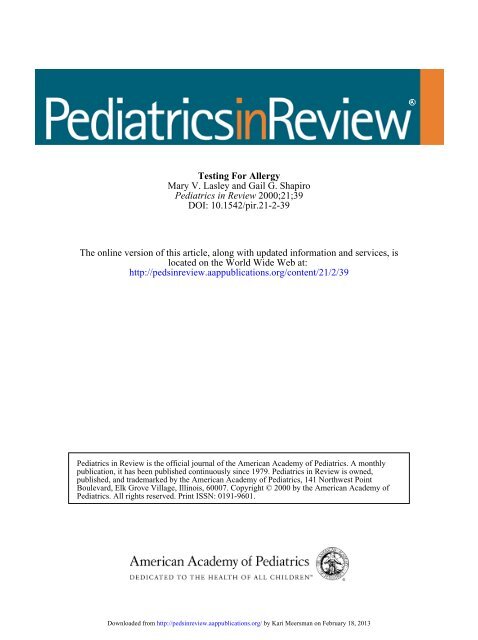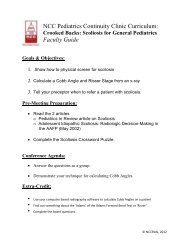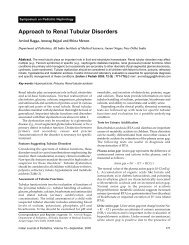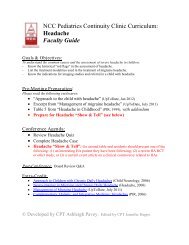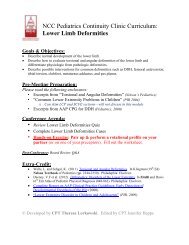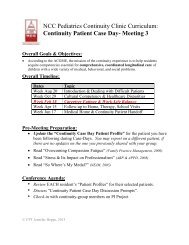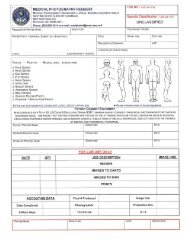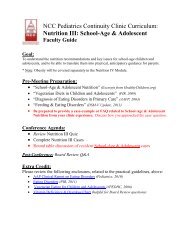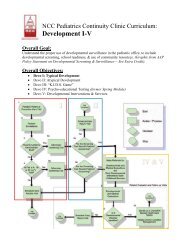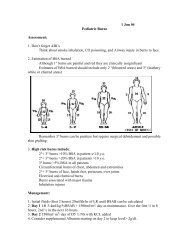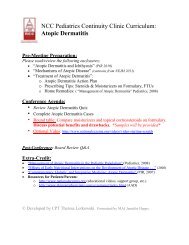Testing for Allergy - NCC Pediatrics Residency at Walter Reed
Testing for Allergy - NCC Pediatrics Residency at Walter Reed
Testing for Allergy - NCC Pediatrics Residency at Walter Reed
You also want an ePaper? Increase the reach of your titles
YUMPU automatically turns print PDFs into web optimized ePapers that Google loves.
<strong>Testing</strong> For <strong>Allergy</strong><br />
Mary V. Lasley and Gail G. Shapiro<br />
<strong>Pedi<strong>at</strong>rics</strong> in Review 2000;21;39<br />
DOI: 10.1542/pir.21-2-39<br />
The online version of this article, along with upd<strong>at</strong>ed in<strong>for</strong>m<strong>at</strong>ion and services, is<br />
loc<strong>at</strong>ed on the World Wide Web <strong>at</strong>:<br />
http://pedsinreview.aappublic<strong>at</strong>ions.org/content/21/2/39<br />
<strong>Pedi<strong>at</strong>rics</strong> in Review is the official journal of the American Academy of <strong>Pedi<strong>at</strong>rics</strong>. A monthly<br />
public<strong>at</strong>ion, it has been published continuously since 1979. <strong>Pedi<strong>at</strong>rics</strong> in Review is owned,<br />
published, and trademarked by the American Academy of <strong>Pedi<strong>at</strong>rics</strong>, 141 Northwest Point<br />
Boulevard, Elk Grove Village, Illinois, 60007. Copyright © 2000 by the American Academy of<br />
<strong>Pedi<strong>at</strong>rics</strong>. All rights reserved. Print ISSN: 0191-9601.<br />
Downloaded from http://pedsinreview.aappublic<strong>at</strong>ions.org/ by Kari Meersman on February 18, 2013
ARTICLE<br />
<strong>Testing</strong> For <strong>Allergy</strong><br />
Mary V. Lasley, MD* and Gail G. Shapiro, MD †<br />
OBJECTIVES<br />
After completing this article, the reader should be able to:<br />
1. List the indic<strong>at</strong>ions <strong>for</strong> immedi<strong>at</strong>e-type skin testing.<br />
2. Deline<strong>at</strong>e the popul<strong>at</strong>ions in which pollen allergy and food allergies<br />
are more common.<br />
3. List the most common medicines th<strong>at</strong> can alter the results of allergy<br />
skin testing.<br />
4. Explain the commonalities and differences between radioallergosorbent<br />
testing and skin testing.<br />
5. Deline<strong>at</strong>e situ<strong>at</strong>ions in which in vitro testing is indic<strong>at</strong>ed.<br />
Why Should We “Skin Test”<br />
P<strong>at</strong>ients?<br />
Many children in the United St<strong>at</strong>es<br />
are affected by <strong>at</strong>opic disease. It has<br />
been estim<strong>at</strong>ed th<strong>at</strong> 4% to 6% of<br />
children have food allergies, 8% to<br />
10% have asthma, and 15% to 25%<br />
have allergic rhinitis. Additionally,<br />
large numbers of children who suffer<br />
from allergic rhinitis have coexisting<br />
otitis media and sinusitis.<br />
Further, there is a widespread<br />
impression th<strong>at</strong> the incidence of<br />
allergic diseases has increased in the<br />
past 15 to 20 years, most notably in<br />
industrialized countries. The purpose<br />
of allergy testing is to help identify<br />
potential allergen(s) th<strong>at</strong> are contributing<br />
to the allergic disease process.<br />
By identifying the allergen, the<br />
p<strong>at</strong>ient and his or her family can<br />
avoid exposures, and the clinician<br />
can manage the disease appropri<strong>at</strong>ely.<br />
<strong>Allergy</strong> testing can be per<strong>for</strong>med<br />
<strong>for</strong> a variety of foods,<br />
aeroallergens, l<strong>at</strong>ex, venom, and<br />
some medic<strong>at</strong>ions.<br />
History of Skin <strong>Testing</strong><br />
Skin testing methods were described<br />
initially more than a century ago. In<br />
1873, Charles Blackley per<strong>for</strong>med<br />
the first allergy skin tests on p<strong>at</strong>ients<br />
by scr<strong>at</strong>ching the surface of their<br />
skin, applying pollen to the scr<strong>at</strong>ch,<br />
and observing the interaction. In<br />
1908, Mantoux described the intradermal<br />
test, which subsequently was<br />
*Clinical Assistant Professor.<br />
† Clinical Professor, University of<br />
Washington Medical Center, Northwest<br />
Asthma & <strong>Allergy</strong> Center, Se<strong>at</strong>tle, WA.<br />
used <strong>for</strong> allergy testing. In the early<br />
1920s, Lewis and Grant described<br />
the prick test. The principles of<br />
allergy testing described in earlier<br />
years remain in practice today, albeit<br />
with modific<strong>at</strong>ions th<strong>at</strong> include standardized<br />
devices and allergen extracts.<br />
How Does Skin <strong>Testing</strong><br />
Work?<br />
Skin testing is a major method <strong>for</strong><br />
identifying allergen-specific immunoglobulin<br />
E (IgE). Allergen is<br />
introduced into the skin and diffuses<br />
through it to interact with IgE th<strong>at</strong> is<br />
bound to mast cells. Cross-linking of<br />
IgE antibodies results in release of<br />
histamine and other chemical medi<strong>at</strong>ors.<br />
The released histamine prompts<br />
the development of a central wheal<br />
and an erythem<strong>at</strong>ous flare. The<br />
wheal and erythema are assessed<br />
15 to 20 minutes after the allergen<br />
has been placed. To interpret skin<br />
test results properly, a positive histamine<br />
and neg<strong>at</strong>ive saline control are<br />
placed <strong>for</strong> comparison. In certain<br />
p<strong>at</strong>ients, a l<strong>at</strong>e-phase reaction occurs<br />
4 or more hours after skin testing.<br />
This results from influx of inflamm<strong>at</strong>ory<br />
cells due to mast cell medi<strong>at</strong>or<br />
release. Although this edem<strong>at</strong>ous<br />
reaction is seen most often in cases<br />
of positive immedi<strong>at</strong>e reactivity (within<br />
15 to 20 min), its assessment and<br />
importance are not clear <strong>at</strong> this time.<br />
In Vivo <strong>Testing</strong><br />
PERCUTANEOUS<br />
Currently, skin testing techniques<br />
are divided into two general c<strong>at</strong>egories:<br />
percutaneous and intradermal<br />
tests. Percutaneous tests are used<br />
most widely. Percutaneous refers to<br />
allergen applied “through” the skin<br />
surface. A small quantity of allergen<br />
is introduced by either a prick or<br />
puncture method. Many commercial<br />
devices are available <strong>for</strong> puncture<br />
testing, including hypodermic needles,<br />
metal lancets, bifurc<strong>at</strong>ed scarifier,<br />
Morrow-Brown needles, and<br />
multitest devices. Percutaneous tests<br />
can be per<strong>for</strong>med on the volar surface<br />
of the arm or upper back; the<br />
l<strong>at</strong>ter site is more reactive. These<br />
tests generally are considered safe,<br />
cost-effective, and specific. The<br />
immedi<strong>at</strong>e availability of results is<br />
an added benefit (Table 1). Percutaneous<br />
tests rarely induce irritant<br />
reactions, and they appear to correl<strong>at</strong>e<br />
better than intradermal tests<br />
with clinical histories and doubleblind<br />
provoc<strong>at</strong>ive challenges with<br />
allergen. Percutaneous tests typically<br />
are evalu<strong>at</strong>ed 15 to 20 minutes after<br />
being placed. A number of scoring<br />
systems <strong>for</strong> evalu<strong>at</strong>ing reactivity<br />
exists. A wheal th<strong>at</strong> has <strong>at</strong> least<br />
3 mm in diameter of indur<strong>at</strong>ion with<br />
surrounding erythema as compared<br />
with the control (diluent) site represents<br />
a positive reaction.<br />
There is no age limit<strong>at</strong>ion <strong>for</strong><br />
per<strong>for</strong>ming percutaneous tests. However,<br />
most clinicians rarely test children<br />
younger than 6 months of age,<br />
and skin testing in these infants<br />
would be limited to a few select<br />
foods, such as milk, soy, and egg or<br />
household inhalants, based on the<br />
infant’s clinical history. Skin test<br />
reactivity may be lessened in very<br />
young children, making positive<br />
(histamine) and neg<strong>at</strong>ive (saline)<br />
controls essential. The number of<br />
skin tests th<strong>at</strong> can be per<strong>for</strong>med in<br />
younger children is limited by their<br />
smaller body surface. Younger children<br />
are more likely to be sensitized<br />
to allergens encountered in early<br />
life, such as foods and household<br />
inhalants (house dust mites, pet dander,<br />
cockroach, and mold). Children<br />
older than 4 years tend to demonstr<strong>at</strong>e<br />
pollen allergies in addition to<br />
those mentioned previously. When<br />
symptoms or exposures change, skin<br />
<strong>Pedi<strong>at</strong>rics</strong> in Review Vol. 21 No. 2 February 2000 39<br />
Downloaded from http://pedsinreview.aappublic<strong>at</strong>ions.org/ by Kari Meersman on February 18, 2013
ALLERGY<br />
<strong>Allergy</strong> <strong>Testing</strong><br />
TABLE 1. Rel<strong>at</strong>ive Advantages of Percutaneous (Prick) and<br />
Intradermal <strong>Testing</strong><br />
VARIABLE<br />
PERCUTANEOUS<br />
TEST<br />
INTRADERMAL<br />
TEST<br />
Simplicity <br />
Speed <br />
Interpret<strong>at</strong>ion of positive and<br />
neg<strong>at</strong>ive reactions<br />
<br />
<br />
Discom<strong>for</strong>t <br />
False-positive reactions Rare Possible<br />
False-neg<strong>at</strong>ive reactions Possible Rare<br />
Reproducibility <br />
Sensitivity <br />
Specificity <br />
Detection of IgE antibodies Yes Yes<br />
Safety <br />
<strong>Testing</strong> of infants Yes Difficult<br />
Modified from Demoly P, Michel F-B, Bousquet J. In vivo methods <strong>for</strong> study of allergy<br />
skin tests, techniques, and interpret<strong>at</strong>ion. In: Middleton E, Jr, <strong>Reed</strong> CE, Ellis EF, et al,<br />
eds. <strong>Allergy</strong> Principles and Practice. 5th ed. St. Louis, Mo: Mosby-Year Book; 1998:<br />
432.<br />
than the percutaneous test. The site<br />
is observed <strong>for</strong> 15 to 20 minutes <strong>for</strong><br />
wheal and erythema. A positive<br />
reaction is considered to be a wheal<br />
th<strong>at</strong> is <strong>at</strong> least 5 mm in diameter<br />
compared with the neg<strong>at</strong>ive (diluent)<br />
control. These tests are considered<br />
100 to 1,000 times more sensitive<br />
than prick tests and are associ<strong>at</strong>ed<br />
with fewer false-neg<strong>at</strong>ive reactions<br />
(Table 1). It is important to use<br />
appropri<strong>at</strong>e concentr<strong>at</strong>ions of allergen<br />
when per<strong>for</strong>ming intradermal<br />
testing because frequent falsepositive<br />
results can be obtained <strong>at</strong><br />
high, irrit<strong>at</strong>ing concentr<strong>at</strong>ions of certain<br />
allergens. The use of multiple<br />
intradermal concentr<strong>at</strong>ions of allergens<br />
more potent than a 1:1,000<br />
concentr<strong>at</strong>ion (end point titr<strong>at</strong>ions) is<br />
discouraged <strong>for</strong> this reason and<br />
because of the questionable value of<br />
the semiquantit<strong>at</strong>ive d<strong>at</strong>a on final<br />
outcome. Due to the low but real<br />
risk <strong>for</strong> anaphylaxis, intradermal<br />
allergy testing should be per<strong>for</strong>med<br />
only in a facility in which personnel<br />
are trained and equipped to manage<br />
these severe reactions.<br />
testing may need to be repe<strong>at</strong>ed.<br />
Examples include an allergic child<br />
whose test results <strong>at</strong> a young age<br />
indic<strong>at</strong>ed sensitivities to foods or<br />
indoor allergens, who now develops<br />
seasonal symptoms or a change in<br />
symptoms after acquiring a new pet<br />
or reloc<strong>at</strong>ing to a different geographic<br />
area.<br />
Disadvantages of percutaneous<br />
testing include dependence on consistent<br />
technique, allergen extract<br />
quality, skin reactivity, discom<strong>for</strong>t,<br />
and the risk of anaphylaxis. Also,<br />
although these tests are specific,<br />
they may lack sensitivity <strong>for</strong> detecting<br />
clinically significant allergies.<br />
The amount of antigen introduced<br />
depends on the prick/puncture size<br />
and the testing device. Loss of<br />
extract potency occurs over time and<br />
can be costly if the clinician per<strong>for</strong>ms<br />
these tests infrequently.<br />
Recent United St<strong>at</strong>es Food and Drug<br />
Administr<strong>at</strong>ion regul<strong>at</strong>ion of allergenic<br />
extracts may help to improve<br />
the quality of skin testing reagents.<br />
Previous use of medic<strong>at</strong>ions th<strong>at</strong><br />
suppress skin testing also may give<br />
false-neg<strong>at</strong>ive results. A review of<br />
f<strong>at</strong>alities from skin testing over a<br />
40-year period reported six f<strong>at</strong>alities<br />
associ<strong>at</strong>ed with skin testing,<br />
although none of these individuals<br />
had undergone prick testing alone.<br />
Systemic reactions have been<br />
observed with percutaneous testing.<br />
INTRADERMAL<br />
Intradermal tests are used commonly<br />
when a significant allergic history is<br />
obtained and results of the percutaneous<br />
tests are neg<strong>at</strong>ive or equivocal.<br />
The intradermal test involves<br />
injecting a specific allergen “within”<br />
the dermal layer of the skin of the<br />
upper arm. When using a 26- to<br />
30-gauge sterile disposable needle,<br />
approxim<strong>at</strong>ely 0.02 mL of allergen<br />
is injected to make a small bleb th<strong>at</strong><br />
is 2 to 3 mm in size, similar to the<br />
per<strong>for</strong>mance of a Mantoux tuberculin<br />
test. Allergen extracts <strong>for</strong> prick<br />
testing generally are diluted to<br />
1:10 to 1:100, but intradermal testing<br />
is per<strong>for</strong>med with allergen<br />
extracts th<strong>at</strong> have a dilution of<br />
1:1,000. Nevertheless, the intradermal<br />
test introduces more allergen<br />
Who Should Be Skin<br />
Tested?<br />
Skin testing can be per<strong>for</strong>med <strong>for</strong><br />
any p<strong>at</strong>ient who has a suspected<br />
IgE-medi<strong>at</strong>ed reaction, but certain<br />
situ<strong>at</strong>ions require clinical judgment.<br />
P<strong>at</strong>ients who have derm<strong>at</strong>ographism<br />
will react to the trauma of the<br />
scr<strong>at</strong>ch with a false-positive result.<br />
P<strong>at</strong>ients who have a history of derm<strong>at</strong>ographism<br />
should have positive<br />
(histamine) and neg<strong>at</strong>ive (diluent)<br />
controls placed prior to any <strong>at</strong>tempt<br />
<strong>at</strong> allergy skin testing to determine<br />
if valid results can be expected.<br />
P<strong>at</strong>ients who have severe eczema<br />
may have such extensive involvement<br />
th<strong>at</strong> skin available <strong>for</strong> testing<br />
is inadequ<strong>at</strong>e. Such p<strong>at</strong>ients can be<br />
tre<strong>at</strong>ed aggressively and tested when<br />
their skin has improved or may be<br />
served better by in vitro testing.<br />
Some medic<strong>at</strong>ions can suppress<br />
skin tests, but a withholding period<br />
may allow successful evalu<strong>at</strong>ion.<br />
Most commonly, antihistamines<br />
inhibit the wheal and flare reaction<br />
to histamine (Table 2). Generally, if<br />
antihistamines are withheld <strong>for</strong> 48 to<br />
72 hours, skin testing can be per<strong>for</strong>med<br />
easily. Older first-gener<strong>at</strong>ion<br />
40 <strong>Pedi<strong>at</strong>rics</strong> in Review Vol. 21 No. 2 February 2000<br />
Downloaded from http://pedsinreview.aappublic<strong>at</strong>ions.org/ by Kari Meersman on February 18, 2013
ALLERGY<br />
<strong>Allergy</strong> <strong>Testing</strong><br />
TABLE 2. Inhibitory Effect of Various Tre<strong>at</strong>ments on IgE-medi<strong>at</strong>ed Skin Tests<br />
DRUGS<br />
SUPPRESSION<br />
GENERIC NAME TRADE NAME DEGREE DURATION CLINICAL SIGNIFICANCE<br />
First-gener<strong>at</strong>ion Anti-H 1 Histamines<br />
Chlorpheniramine Chlor-trimetron 1 to 3 days Yes<br />
Clemastine Tavist 1 to 10 days Yes<br />
Cyproheptadine Periactin 0to 1 to 8 days Yes<br />
Diphenhydramine Benadryl 0to 1 to 3 days Yes<br />
Hydroxyzine Atarax 1 to 10 days Yes<br />
Second-gener<strong>at</strong>ion Anti-H 1 Histamines<br />
Astemizole Hismanal 30 to 60 days Yes<br />
Azelastine Astelin 3 to 10 days Yes<br />
Cetirizine Zyrtec 3 to 10 days Yes<br />
Lor<strong>at</strong>adine Claritin 3 to 10 days Yes<br />
Terfenadine Seldane 3 to 10 days Yes<br />
Anti-H 2 Histamines<br />
Cimetidine Tagamet 0to No<br />
Ranitidine Zantac No<br />
Corticosteroids<br />
Systemic, short-term 0 No<br />
Systemic, long-term Possible Yes<br />
Inhaled 0 No<br />
Topical skin 0 to Yes<br />
Antiasthma Medic<strong>at</strong>ions<br />
Beta-2 agonists, inhaled 0 to No<br />
Cromolyn Intal 0 No<br />
Nedocromil Tilade 0 No<br />
Theophylline 0 to No<br />
Tricyclic Antidepressants<br />
Doxepin Sinequan 3 to 11 days Yes<br />
Imipramines 10 days Yes<br />
Phenothiazines Yes<br />
Modified from Demoly P, Michel F-B, Bousquet J. In vivo methods <strong>for</strong> study of allergy skin tests, techniques, and interpret<strong>at</strong>ion. In:<br />
Middleton E Jr, <strong>Reed</strong> CE, Ellis EF, et al, eds. <strong>Allergy</strong> Principles and Practice. 5th ed. St. Louis, Mo: Mosby-Year Book; 1998:434.<br />
antihistamines may interfere with<br />
skin test reactivity <strong>for</strong> up to<br />
24 hours. Newer second-gener<strong>at</strong>ion<br />
antihistamines have longer half-lives<br />
and can block the reaction <strong>for</strong> 3 to<br />
10 days, except <strong>for</strong> astemizole,<br />
which may produce interference <strong>for</strong><br />
30 to 60 days. Some other drugs,<br />
such as tricyclic antidepressants,<br />
have potent antihistaminic effects<br />
and may interfere with per<strong>for</strong>mance<br />
of skin tests. H 2 antagonists (eg,<br />
cimetidine, ranitidine) have a limited<br />
inhibitory effect, and stopping these<br />
medic<strong>at</strong>ions on the day of skin testing<br />
probably is sufficient. Asthma<br />
medic<strong>at</strong>ions, including inhaled corticosteroids,<br />
cromolyn, nedocromil,<br />
beta-2 agonists, theophylline, and a<br />
short burst of oral corticosteroids, do<br />
not suppress skin testing results.<br />
There<strong>for</strong>e, these medic<strong>at</strong>ions do not<br />
need to be stopped. High-dose, longterm<br />
oral steroids and potent topical<br />
steroids applied to the skin test site<br />
<strong>for</strong> a period of 1 week or longer<br />
may suppress skin test results.<br />
<strong>Pedi<strong>at</strong>rics</strong> in Review Vol. 21 No. 2 February 2000 41<br />
Downloaded from http://pedsinreview.aappublic<strong>at</strong>ions.org/ by Kari Meersman on February 18, 2013
ALLERGY<br />
<strong>Allergy</strong> <strong>Testing</strong><br />
TABLE 3. Determin<strong>at</strong>ion of Specific IgE by Skin <strong>Testing</strong><br />
and RAST*<br />
VARIABLE SKIN TEST RAST<br />
Risk of allergic reaction Yes No<br />
Sensitive Very Less<br />
Affected by antihistamines Yes No<br />
Affected by corticosteroids Usually not No<br />
Affected by extensive derm<strong>at</strong>itis<br />
or derm<strong>at</strong>ographism<br />
In Vitro <strong>Testing</strong><br />
In vitro testing is indic<strong>at</strong>ed <strong>for</strong><br />
p<strong>at</strong>ients who have severe cutaneous<br />
disease, cannot discontinue medic<strong>at</strong>ions<br />
th<strong>at</strong> interfere with skin testing,<br />
or have experienced severe anaphylaxis.<br />
The discovery of IgE in 1967<br />
has played a large role in the scientific<br />
advancement of allergic disease.<br />
Subsequently, in vitro tests were<br />
developed to measure levels of<br />
antigen-specific IgE. Radioallergosorbent<br />
test (RAST) and enzymelinked<br />
immunosorbent assay<br />
(ELISA) are used commonly.<br />
Although good correl<strong>at</strong>ion exists <strong>for</strong><br />
high titers of antigen-specific IgE as<br />
identified by in vitro tests and skin<br />
tests, in vitro testing generally is not<br />
as sensitive as skin testing in defining<br />
clinically pertinent allergens<br />
Yes<br />
Broad selection of antigens Yes No<br />
Immedi<strong>at</strong>e results Yes No<br />
Expensive No Yes<br />
Semiquantit<strong>at</strong>ive No Yes<br />
Lability of allergens Yes No<br />
*RAST Radioallergosorbent test as an example of other in vitro tests.<br />
Modified from Sly RM. Allergic disorders. In: Behrman RE, Kliegman RM, Arvin AM,<br />
eds. Nelson Textbook of <strong>Pedi<strong>at</strong>rics</strong>. 15th ed. Philadelphia, Penn: WB Saunders Co;<br />
1996:617.<br />
No<br />
(Table 3). For highly <strong>at</strong>opic p<strong>at</strong>ients<br />
who have elev<strong>at</strong>ed total IgE, a nonspecific<br />
binding occurs th<strong>at</strong> results<br />
in lessened specificity. Additional<br />
disadvantages of in vitro testing are<br />
increased cost, delays in providing<br />
results, and labor<strong>at</strong>ory reliability.<br />
Selection of a reliable labor<strong>at</strong>ory is<br />
fundamental. Most RAST tests are<br />
semiquantit<strong>at</strong>ive and reported in<br />
arbitrary units on scales ranging<br />
from 0 to 4 or 0 to 6. Assessment of<br />
threshold values <strong>for</strong> clinical significance<br />
is difficult to interpret. It is<br />
inappropri<strong>at</strong>e to send specimens <strong>for</strong><br />
extensive RAST testing without paying<br />
careful <strong>at</strong>tention to the clinical<br />
history and the relevant antigens.<br />
RAST testing involves a sandwich<br />
method in which specific antigen<br />
is <strong>at</strong>tached to a solid-phase<br />
paper disc (allergosorbent) (Figure).<br />
The solid-phase disc is incub<strong>at</strong>ed<br />
with the p<strong>at</strong>ient’s serum, which contains<br />
IgE antibody. Unbound antibody<br />
is removed, and radiolabeled<br />
anti-IgE antibody added. A gamma<br />
scintill<strong>at</strong>ion counter measures the<br />
amount of radioactivity as a reflection<br />
of the amount of specific IgE in<br />
the p<strong>at</strong>ient’s serum. Results are<br />
compared with standard reference<br />
sera.<br />
Another version of the RAST<br />
measures IgG or IgG4 (r<strong>at</strong>her than<br />
IgE) <strong>for</strong> specific food allergens.<br />
Because there is no correl<strong>at</strong>ion<br />
between positive IgG or IgG4 RAST<br />
results and clinical disease, these<br />
tests serve no purpose, and their use<br />
<strong>for</strong> evalu<strong>at</strong>ing purported food allergy<br />
should be discouraged.<br />
The principles of ELISA are<br />
identical to those of RAST except<br />
th<strong>at</strong> an enzym<strong>at</strong>ic marker is used<br />
r<strong>at</strong>her than a radioactive marker.<br />
The solid-phase component consists<br />
of polystyrene pl<strong>at</strong>es, tubes, or<br />
beads th<strong>at</strong> provide a binding site <strong>for</strong><br />
the specific antigen. The p<strong>at</strong>ient’s<br />
serum, containing the antibody, is<br />
added to the antigen-co<strong>at</strong>ed solidphase.<br />
The presence of bound antibody<br />
is detected by using a second<br />
antibody th<strong>at</strong> is enzyme-labeled. On<br />
binding, a colored reaction product<br />
is produced, which can be measured<br />
spectrophotometrically.<br />
Are All Tests Appropri<strong>at</strong>e <strong>for</strong><br />
All P<strong>at</strong>ients?<br />
One of the most important aspects<br />
of allergy testing is to correl<strong>at</strong>e the<br />
test with the clinical history. For<br />
children who have seasonal symptoms,<br />
testing is per<strong>for</strong>med <strong>for</strong> the<br />
pollens th<strong>at</strong> are found in the highest<br />
concentr<strong>at</strong>ions <strong>at</strong> the time of the<br />
FIGURE. The principle of the radioallergosorbent test (RAST).<br />
42 <strong>Pedi<strong>at</strong>rics</strong> in Review Vol. 21 No. 2 February 2000<br />
Downloaded from http://pedsinreview.aappublic<strong>at</strong>ions.org/ by Kari Meersman on February 18, 2013
year when the child is symptom<strong>at</strong>ic.<br />
For example, trees usually pollin<strong>at</strong>e<br />
in early spring, grasses in l<strong>at</strong>e spring<br />
to summer, and weeds from summer<br />
through fall. The regional flora<br />
determines pollen exposure. Most<br />
flora causing significant allergic<br />
reactions are wind-pollin<strong>at</strong>ed, and<br />
their pollen can travel many miles.<br />
For children who have perennial<br />
symptoms, the likely allergens<br />
include dust mites, pet dander, cockroach<br />
spores, and mold spores.<br />
Aeroallergen testing generally is<br />
viewed as correl<strong>at</strong>ing well with the<br />
p<strong>at</strong>ient’s symptoms. On the other<br />
hand, food testing, whether by skin<br />
tests or in vitro techniques, is<br />
deemed less reliable. Caution should<br />
be used when interpreting food skin<br />
tests because only a small fraction<br />
of p<strong>at</strong>ients who have a positive food<br />
skin test will react when a doubleblind<br />
placebo-controlled food challenge<br />
is per<strong>for</strong>med. The avoidance<br />
of foods in the diet never should be<br />
based on skin test or in vitro test<br />
results alone. For children who have<br />
a clinical allergic history of food<br />
reactions, skin testing can help confirm<br />
the suspected food allergen. It<br />
also can be helpful in children who<br />
have eczema, whose rash may be<br />
triggered by ingestion of certain<br />
foods. The most common food allergies<br />
in children are to milk, whe<strong>at</strong>,<br />
soy, egg, peanut, tree nuts, and fish.<br />
Although many children outgrow<br />
milk, whe<strong>at</strong>, soy, and egg allergy,<br />
peanuts, tree nuts, and fish typically<br />
elicit life-long reactions and can<br />
result in severe, life-thre<strong>at</strong>ening anaphylaxis.<br />
The practice of placing<br />
children who supposedly have<br />
extensive food allergies on highly<br />
restrictive diets should be discouraged,<br />
especially when the clinical<br />
history does not reveal an allergic<br />
response to the food ingestion. It is<br />
important to remember th<strong>at</strong> behavioral<br />
issues such as poor sleeping,<br />
crying, and hyperactivity, are<br />
nonIgE reactions. A board-certified<br />
allergist often can help families differenti<strong>at</strong>e<br />
between allergic (IgE)<br />
reactions and food intolerances<br />
(nonIgE).<br />
Who is an Allergist?<br />
The board-certified allergist has<br />
completed a 2- to 3-year period of<br />
concentr<strong>at</strong>ed study in the field of<br />
allergic and immunologic diseases<br />
after having completing a pedi<strong>at</strong>ric<br />
or internal medicine residency.<br />
Board certific<strong>at</strong>ion entails successful<br />
completion of the pedi<strong>at</strong>ric or internal<br />
medicine boards and the allergy<br />
and immunology boards. Like the<br />
pedi<strong>at</strong>ric board certific<strong>at</strong>ion, which<br />
must be renewed every 7 years, the<br />
allergy and immunology board certific<strong>at</strong>ion<br />
must be renewed every<br />
10 years. In making a referral to a<br />
board-certified/board-eligible allergist,<br />
the primary care physician<br />
should assume th<strong>at</strong> an appropri<strong>at</strong>e<br />
history and physical examin<strong>at</strong>ion<br />
will be per<strong>for</strong>med to determine<br />
which diagnostic tests, including<br />
skin tests, are indic<strong>at</strong>ed. Most<br />
importantly, these tests will be interpreted<br />
<strong>for</strong> the p<strong>at</strong>ient and the referring<br />
physician. In addition, advice<br />
<strong>for</strong> allergen avoidance and proper<br />
medical management should be<br />
discussed.<br />
Conclusion<br />
<strong>Allergy</strong> skin testing represents one<br />
of the major tools in the diagnosis<br />
of IgE-medi<strong>at</strong>ed diseases. When per<strong>for</strong>med<br />
properly, it yields important<br />
in<strong>for</strong>m<strong>at</strong>ion, but the interpret<strong>at</strong>ion of<br />
these tests requires correl<strong>at</strong>ion with<br />
the p<strong>at</strong>ient’s history and physical<br />
examin<strong>at</strong>ion because the presence of<br />
IgE antibodies alone does not equ<strong>at</strong>e<br />
with disease. Conferring with a<br />
board-certified allergist should maximize<br />
the care of the affected p<strong>at</strong>ient.<br />
SUGGESTED READING<br />
Bernstein IL, Storms WW. Practice parameters<br />
<strong>for</strong> allergy diagnostic testing. Ann<br />
<strong>Allergy</strong> Asthma Immunol. 1995;75(SIII):<br />
543–625<br />
Demoly P, Michel F-B, Bousquet J. In vivo<br />
methods <strong>for</strong> study of allergy skin tests,<br />
techniques, and interpret<strong>at</strong>ion. In: Middleton<br />
E Jr, <strong>Reed</strong> CE, Ellis EF, et al, eds.<br />
<strong>Allergy</strong> Principles and Practice. 5th ed. St.<br />
Louis, Mo: Mosby-Year Book; 1998:<br />
430–439<br />
Ownby DR. Test <strong>for</strong> IgE antibody. In: Bierman<br />
CW, Pearlman DS, Shapiro GG, et al,<br />
eds. <strong>Allergy</strong>, Asthma, and Immunology<br />
from Infancy to Adulthood. 3rd ed. Philadelphia,<br />
Penn: WB Saunders Co; 1996:<br />
144–156<br />
Sly RM. Allergic disorders. In: Behrman RE,<br />
Kliegman RM, Arvin AM, eds. Nelson<br />
Textbook of <strong>Pedi<strong>at</strong>rics</strong>. 15th ed. Philadelphia,<br />
Penn: WB Saunders Co; 1996:<br />
610–618<br />
ALLERGY<br />
<strong>Allergy</strong> <strong>Testing</strong><br />
PIR QUIZ<br />
Quiz also available online <strong>at</strong><br />
www.pedsinreview.org.<br />
1. You are asked to evalu<strong>at</strong>e a<br />
6-year-old child who has a known<br />
history of asthma <strong>for</strong> allergy to<br />
trees, grasses, and weeds. He is<br />
being tre<strong>at</strong>ed with inhaled<br />
beclomethasone, albuterol,<br />
cromolyn sodium, and theophylline<br />
<strong>for</strong> reactive airway disease and<br />
diphenhydramine <strong>for</strong> allergic<br />
rhinitis. Which of the following is<br />
most likely to interfere with allergy<br />
skin testing?<br />
A. Albuterol.<br />
B. Beclomethasone<br />
C. Cromolyn sodium.<br />
D. Diphenhydramine.<br />
E. Theophylline.<br />
2. Which of the following allergenspecific<br />
immunoglobulins is<br />
involved in skin testing <strong>for</strong> allergy?<br />
A. Immunoglobulin A.<br />
B. Immunoglobulin D.<br />
C. Immunoglobulin E.<br />
D. Immunoglobulin G.<br />
E. Immunoglobulin M.<br />
3. You are evalu<strong>at</strong>ing a 12-year-old<br />
girl who has <strong>at</strong>opic derm<strong>at</strong>itis and<br />
allergy to multiple agents. Which<br />
of the following is the most important<br />
advantage of radioallergosorbent<br />
test (RAST) over skin testing<br />
<strong>for</strong> allergy?<br />
A. Increased specificity in <strong>at</strong>opic<br />
p<strong>at</strong>ients.<br />
B. Lower cost.<br />
C. Not influenced by antihistamines.<br />
D. Rapidity of diagnosis.<br />
E. <strong>Testing</strong> <strong>for</strong> gre<strong>at</strong>er number of<br />
allergens.<br />
4. Which of the following is a true<br />
st<strong>at</strong>ement regarding testing <strong>for</strong><br />
allergy?<br />
A. Avoidance of suspected food<br />
allergen should be based on<br />
skin testing.<br />
B. Intradermal skin testing carries<br />
lower risk of anaphylaxis<br />
compared with percutaneous<br />
skin testing.<br />
C. Percutaneous skin testing has<br />
high specificity but low sensitivity<br />
<strong>for</strong> clinically significant<br />
allergies.<br />
D. RAST is more reliable than<br />
skin testing.<br />
E. Skin test reactivity is increased<br />
in young infants.<br />
<strong>Pedi<strong>at</strong>rics</strong> in Review Vol. 21 No. 2 February 2000 43<br />
Downloaded from http://pedsinreview.aappublic<strong>at</strong>ions.org/ by Kari Meersman on February 18, 2013
<strong>Testing</strong> For <strong>Allergy</strong><br />
Mary V. Lasley and Gail G. Shapiro<br />
<strong>Pedi<strong>at</strong>rics</strong> in Review 2000;21;39<br />
DOI: 10.1542/pir.21-2-39<br />
Upd<strong>at</strong>ed In<strong>for</strong>m<strong>at</strong>ion &<br />
Services<br />
References<br />
Subspecialty Collections<br />
Permissions & Licensing<br />
Reprints<br />
including high resolution figures, can be found <strong>at</strong>:<br />
http://pedsinreview.aappublic<strong>at</strong>ions.org/content/21/2/39<br />
This article cites 1 articles, 0 of which you can access <strong>for</strong> free <strong>at</strong>:<br />
http://pedsinreview.aappublic<strong>at</strong>ions.org/content/21/2/39#BIBL<br />
This article, along with others on similar topics, appears in the<br />
following collection(s):<br />
<strong>Allergy</strong> and Rel<strong>at</strong>ed Disorders<br />
http://pedsinreview.aappublic<strong>at</strong>ions.org/cgi/collection/allergy_re<br />
l<strong>at</strong>ed_disorders<br />
Respir<strong>at</strong>ory Disorders<br />
http://pedsinreview.aappublic<strong>at</strong>ions.org/cgi/collection/respir<strong>at</strong>or<br />
y_disorders<br />
In<strong>for</strong>m<strong>at</strong>ion about reproducing this article in parts (figures,<br />
tables) or in its entirety can be found online <strong>at</strong>:<br />
/site/misc/Permissions.xhtml<br />
In<strong>for</strong>m<strong>at</strong>ion about ordering reprints can be found online:<br />
/site/misc/reprints.xhtml<br />
Downloaded from http://pedsinreview.aappublic<strong>at</strong>ions.org/ by Kari Meersman on February 18, 2013


